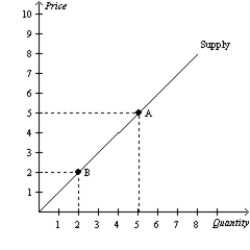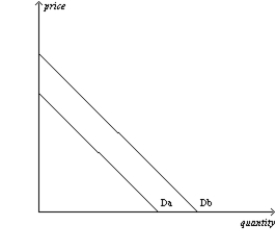Correct Answer

verified
Correct Answer
verified
Multiple Choice
Today, people changed their expectations about the future. This change
A) can cause a movement along a demand curve.
B) can affect future demand but not today's demand.
C) can affect today's demand.
D) cannot affect either today's demand or future demand.
Correct Answer

verified
Correct Answer
verified
True/False
Supply refers to the position of the supply curve, whereas the quantity supplied refers to the amount suppliers wish to sell.
Correct Answer

verified
Correct Answer
verified
Multiple Choice
Table 4-8
 -Refer to Table 4-8. If these are the only three sellers in the market, then an increase in the market price from $6 to $12 will increase quantity supplied by
-Refer to Table 4-8. If these are the only three sellers in the market, then an increase in the market price from $6 to $12 will increase quantity supplied by
A) 12 units.
B) 24 units.
C) 36 units.
D) 48 units.
Correct Answer

verified
Correct Answer
verified
Short Answer
Table 4-14
The table below shows the quantities demanded of milk per month by four families at various prices.
 -Refer to Table 4-14. If the four families listed are the only demanders in this market and the price of a gallon of milk is $4.00, what is the market quantity demanded?
-Refer to Table 4-14. If the four families listed are the only demanders in this market and the price of a gallon of milk is $4.00, what is the market quantity demanded?
Correct Answer

verified
Correct Answer
verified
True/False
A yard sale is an example of a market.
Correct Answer

verified
Correct Answer
verified
Multiple Choice
Figure 4-10  -Refer to Figure 4-10. The movement from Point A to Point B represents an)
-Refer to Figure 4-10. The movement from Point A to Point B represents an)
A) increase in the price.
B) decrease in the quantity supplied.
C) shift in the supply curve.
D) Both a and b are correct.
Correct Answer

verified
Correct Answer
verified
True/False
A surplus is the same as an excess demand.
Correct Answer

verified
Correct Answer
verified
Multiple Choice
A market includes
A) buyers only.
B) sellers only.
C) both buyers and sellers.
D) the place where transactions occur but not the people involved.
Correct Answer

verified
Correct Answer
verified
Multiple Choice
Equilibrium price must increase when demand
A) increases and supply does not change, when demand does not change and supply decreases, and when demand decreases and supply increases simultaneously.
B) increases and supply does not change, when demand does not change and supply decreases, and when demand increases and supply decreases simultaneously.
C) decreases and supply does not change, when demand does not change and supply increases, and when demand decreases and supply increases simultaneously.
D) decreases and supply does not change, when demand does not change and supply increases, and when demand increases and supply decreases simultaneously.
Correct Answer

verified
Correct Answer
verified
Multiple Choice
Which of the following characteristics is required for a perfectly competitive market?
A) The goods offered for sale are exactly the same.
B) There are so many buyers and sellers that no single buyer or seller has any influence over the market price.
C) It is difficult for new sellers to enter the market.
D) Both a and b are correct.
Correct Answer

verified
Correct Answer
verified
Multiple Choice
An increase in the price of a good will
A) increase demand.
B) decrease demand.
C) increase quantity demanded.
D) decrease quantity demanded.
Correct Answer

verified
Correct Answer
verified
Multiple Choice
A monopoly is a market with one
A) seller, and that seller is a price taker.
B) seller, and that seller sets the price.
C) buyer, and that buyer is a price taker.
D) buyer, and that buyer sets the price.
Correct Answer

verified
Correct Answer
verified
Multiple Choice
Which of the following events must cause equilibrium price to rise?
A) demand increases and supply decreases
B) demand and supply both decrease
C) demand decreases and supply increases
D) demand and supply both increase
Correct Answer

verified
Correct Answer
verified
Multiple Choice
The law of supply and demand asserts that
A) demand curves and supply curves tend to shift to the right as time goes by.
B) the price of a good will eventually rise in response to an excess demand for that good.
C) when the supply curve for a good shifts, the demand curve for that good shifts in response.
D) the equilibrium price of a good will be rising more often than it will be falling.
Correct Answer

verified
Correct Answer
verified
Multiple Choice
If muffins and bagels are substitutes, a higher price for bagels would result in a(n)
A) increase in the demand for bagels.
B) decrease in the demand for bagels.
C) increase in the demand for muffins.
D) decrease in the demand for muffins.
Correct Answer

verified
Correct Answer
verified
True/False
If a person expects the price of pumpkins to increase next month, then that person's current demand for pumpkins will increase.
Correct Answer

verified
Correct Answer
verified
Multiple Choice
Which of the following would shift the supply of Green Bay Packers football jerseys to the left?
A) The Green Bay Packers make it to the Super Bowl.
B) The price of the jerseys increases by $15.
C) The technology of sewing machines use to make the jerseys improves.
D) The cost of the fabric used to make the jerseys increases.
Correct Answer

verified
Correct Answer
verified
Multiple Choice
Figure 4-7  -Refer to Figure 4-7. The shift from Db to Da is called
-Refer to Figure 4-7. The shift from Db to Da is called
A) an increase in demand.
B) a decrease in demand.
C) a decrease in quantity demanded.
D) an increase in quantity demanded.
Correct Answer

verified
Correct Answer
verified
Multiple Choice
What would happen to the equilibrium price and quantity of lattés if coffee shops began using a machine that reduced the amount of labor necessary to produce steamed milk, which is used to make lattés, and scientists discovered that coffee prevents heart attacks?
A) Both the equilibrium price and quantity would increase.
B) Both the equilibrium price and quantity would decrease.
C) The equilibrium price would increase, and the effect on equilibrium quantity would be ambiguous.
D) The equilibrium quantity would increase, and the effect on equilibrium price would be ambiguous.
Correct Answer

verified
Correct Answer
verified
Showing 21 - 40 of 700
Related Exams